Our solar system is only one in an estimated several billion in the Milky Way Galaxy. The Solar System is over 4.5 billion years old.
Since mankind arose, people have looked to the stars, believing them to be Gods. Some called them the ‘Wanderers’ and invested complex mythology in them. Many cultures worshipped them through song, praise, prayer, and even ritual sacrifice. For thousands of years, people thought the planets, moons, and Sun revolved around the Earth, and that the Earth was the center of the universe.
Invention of Telescopes
When telescopes were invented in the seventeenth century, people began to think that the Earth wasn’t the center of the universe and that the planets did not revolve around the Earth, but rather the Sun. This concept was called heliocentrism. People started thinking of the planets as worlds very much like our own, and not the mythological Gods people thought they were. People started to think that other civilizations existed on other planets. As telescopes were improved, more planets were found. Uranus, Neptune, and Pluto. There may even be other planets beyond Pluto, but only time will solve the answer to that question.
Our Solar System
Our Solar System was created when a nebula, made up of mostly hydrogen, gradually collapsed and formed a spinning protostar. Gravitational contraction heated the protostar and a nuclear fission reaction was sparked in the hot, dense gas that condensed at its center. Our Sun was born. The planets were formed from the remaining disc of material still swirling around our new-born Sun. The largest four of our planets were composed of mainly hydrogen as well as helium. They and the Sun are relics of protostellar material that existed 4.6 billion years ago. The impurities went to form the terrestrial planets.
Regions of the Solar System
- The inner Solar System consists of the rocky terrestrial planets Mercury, Venus, Earth, and Mars.
- The Asteroid Belt between the orbits of Mars and Jupiter.
- The outgas giant planets consisting of Jupiter, Saturn, Uranus, and Neptune.
- The Kuiper Belt, a region (ring) of asteroids and comets lying beyond the orbit of Neptune.
- The Oort Cloud, a spherical shell that is made up of dormant comets.
The Sun
The Sun (also known as Sol and Helios) was created in the center of a spinning protostar. The Sun is a G2 star, one of more than 100 billion in our galaxy. It makes up 99.8% of the mass of our Solar System and weighs 1.989e30 kg. Its diameter is 1,390,000 km and has a core temperature of 15,600,000 kelvin. The surface temperature is 5800 kelvin (except for sunspots which have a temperature of 3800 k). At present, the Sun consists of 75% hydrogen, 25% helium and the rest (metals) add up to only 0,1%. By the number of atoms, 92.1% is hydrogen and 7.8% is helium.
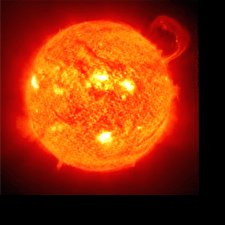 The outer layers of the Sun rotate at different rates to the core. At the Sun’s equator, the surface rotates once every 25.4 days. Near the poles, it’s as much as 36 days. This is because the Sun is not a solid body like Earth. Similar effects are seen in the Gas Planets. Its differential rotation extends down into the interior of the Sun, but the core rotates as a solid body.
The outer layers of the Sun rotate at different rates to the core. At the Sun’s equator, the surface rotates once every 25.4 days. Near the poles, it’s as much as 36 days. This is because the Sun is not a solid body like Earth. Similar effects are seen in the Gas Planets. Its differential rotation extends down into the interior of the Sun, but the core rotates as a solid body.
The surface of the Sun is called the photosphere and is at a temperature of 5800K. Sunspots are ‘cool’ regions on the photosphere, at a temperature of only 3800K. They are dark spots on the surface of the Sun and can be up to 50,000 km in diameter. Above the photosphere is the chromosphere. The region above the chromosphere, called the corona, extends millions of kilometers into space but is visible only during eclipses.
As well as heat and light, the Sun also emits a low-density stream of charged particles (mainly protons and electrons) known as the ‘solar wind’ and propagates throughout the Solar System at around 450 km/sec. The solar wind and the much higher energy particles ejected by solar flares can have dramatic effects on the Earth ranging from power line surges to radio interference and the beautiful aurora borealis.
The Sun is around 4.5 billion years old. It has used up about half of the hydrogen in its core. It will continue to radiate ‘peacefully’ for another 5 billion years. Eventually, it will run out of hydrogen fuel and will be forced to use helium, and will eventually destroy Earth and create a planetary nebula.
Facts about Each Planet
By some definitions, the size of the Solar System is almost two light-years!
Earth Facts
Earth is the only planet in our Solar System capable of sustaining life. Located 149,600,000 kilometers (1AU) from the Sun, the Earth is the third of the four terrestrial planets. It is also the largest, with a diameter of 12,756 kilometers. Earth’s atmosphere is much less dense than Venus’, but much denser than Mars’. It consists of mainly Nitrogen and Oxygen.
Earth’s clouds, which are composed mainly of water vapor, are spread roughly over about half the planet at any given time, in constantly changing patterns. These clouds exist in the seven-mile deep troposphere, which is the lowest and densest layer of the Earth’s atmosphere.
Above the troposphere is the stratosphere, which is 40 kilometers thick. The ozone (O3) in the ozone layer in the stratosphere prevents solar ultraviolet radiation from reaching the Earth.
Above this layer is the mesosphere, which is 32 kilometers thick, and above that is the ionosphere, which is 160 kilometers thick. A total of 250 kilometers above the surface. Manned spacecraft (e.g: Russian (formerly Soviet) space stations and the ISS) operate at about 400-480 kilometers above ground level and are well above the Earth’s atmosphere. At this altitude, the troposphere and stratosphere appear as a narrow blue band on the Earth’s horizon, while the other layers are too faint to be seen at all.
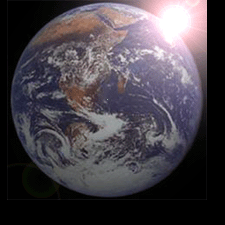 Temperatures on Earth vary from 60 Degrees C, to -100 degrees C, although the mean temperature is 15 degrees C, suitable for sustaining life. The Earth rotates on its axis every 24 hours, and an Earth year is approximately 365 days.
Temperatures on Earth vary from 60 Degrees C, to -100 degrees C, although the mean temperature is 15 degrees C, suitable for sustaining life. The Earth rotates on its axis every 24 hours, and an Earth year is approximately 365 days.
Water covers 3/4 of the Earth’s surface. The Earth’s crust is 40 km thick and is composed mainly of silicate rock. beneath this surface is a mantle, which consists of semi-molten silicate rock 2900 km thick.
The Earth’s core is a sphere of molten iron (with some nickel), roughly 6720 miles in diameter. Earth is the second most geologically active body in the solar system (Io is the first).
- The word “Earth” comes from the Old English word “ertha,” meaning ground or land.
- Despite what is commonly believed, the Earth has been known to be (roughly) spherical since antiquity.
- Earth is the only known body in the universe to possess life.
Until the 16th century, the Earth was believed to be the center of the universe, with all objects orbiting around it. - Earth’s atmosphere is composed of 78% nitrogen, 21% oxygen, and trace amounts of other gases including argon and carbon dioxide.
- The substantial amount of oxygen found on Earth is the result of plantlife’s consumption of carbon dioxide during the process of photosynthesis.
- An important component of Earth’s atmosphere is the Ozone Layer— “shell” of a special type of oxygen that protects the Earth from harmful solar radiation.
- Oceans cover over 70% of Earth’s surface.
- The first life on Earth developed in the oceans.
- Earth’s water was initially trapped within the planet; however, over time this water was brought to the surface as a result of the planet’s volcanic activity.
- Only 30% of Earth’s surface is dry land.
- Compared with other solid bodies in the Solar System, the Earth’s surface has relatively few visible impact craters. The lack of craters is due to Earth’s geological processes reshaping its surface.
- Earth’s highest point is Mount Everest. Its height is 8.8 km.
- Earth’s lowest point is Challenger Deep, found 10.9 km beneath sea level.
- Earth is the fifth largest planet in the Solar System and largest of the terrestrial planets.
- The orbit of Earth is one of the most circulars of all the planets.
- One year on Earth last a little over 365 days. This “little over” part is almost 1/4 of a day, and hence the reason we have a leap year every 4 years.
- The axis around which Earth rotates is tilted 23°. The effect of this tilt is the different seasons we experience.
Jupiter Facts
Jupiter is the largest planet in the solar system with a diameter of 142,984 kilometers, it has 1330 times the volume and 318 times the mass of Earth. Jupiter is 816 million kilometers from the Sun and appears as the fourth largest object in the sky as viewed from Earth (Sun, Moon, and Venus are brighter).
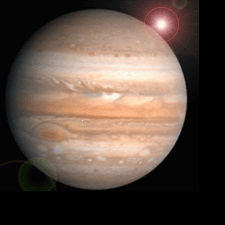 A Jovian year consists of 4333 Earth days, although a day only lasts 9.84 hours. This rapid rotation combined with Jupiter’s very active atmospheric weather pattern gives Jupiter a very violent appearance. Pioneer 10, Voyager 1 and 2 all made close up fly-bys between March 1972 and July 1979. Jupiter does not have a solid surface or a molten core, but rather it is gaseous and has a small, solid core. Above the core is a sphere of frozen water combined with frozen ammonia that is 6880 kilometers thick, which is kept frozen by immense pressure rather than temperature. This enormous block of ice averages 15,000 degrees C. Above this is a layer of liquid metallic hydrogen 46,000 kilometers deep, topped by a 16,000-kilometer ocean of liquid hydrogen. The temperature of the liquid hydrogen is 150 degrees C. Above this is the planets turbulent atmosphere. Its atmosphere contains acetylene, ethane, methane, ammonia, carbon monoxide, phosphine, and even water.
A Jovian year consists of 4333 Earth days, although a day only lasts 9.84 hours. This rapid rotation combined with Jupiter’s very active atmospheric weather pattern gives Jupiter a very violent appearance. Pioneer 10, Voyager 1 and 2 all made close up fly-bys between March 1972 and July 1979. Jupiter does not have a solid surface or a molten core, but rather it is gaseous and has a small, solid core. Above the core is a sphere of frozen water combined with frozen ammonia that is 6880 kilometers thick, which is kept frozen by immense pressure rather than temperature. This enormous block of ice averages 15,000 degrees C. Above this is a layer of liquid metallic hydrogen 46,000 kilometers deep, topped by a 16,000-kilometer ocean of liquid hydrogen. The temperature of the liquid hydrogen is 150 degrees C. Above this is the planets turbulent atmosphere. Its atmosphere contains acetylene, ethane, methane, ammonia, carbon monoxide, phosphine, and even water.
The most outstanding feature on Jupiter is the Great Red Spot (GRS), First recorded in 1664 by Robert Hooke. It is three times the size of Earth and is a giant cyclonic storm. It rotates anticlockwise and makes a complete rotation every six Earth days.
In 1979, the Voyager spacecraft discovered a distinct ring system. The Jovian rings are very thin compared to Saturn’s. The ring system is divided into two parts that begin 46,000 kilometers above Jupiter’s cloud tops. The two parts are a faint band 5000 kilometers across, feathering into a brighter band 800 kilometers across. The rings are composed of dark grains of sands and dust and are probably not more than 1.6 kilometers thick.
- Jupiter has been known to humanity since antiquity due to it being visible to the naked eye. However, it was believed to be a star by ancient peoples and only within the last several hundred years was it realized to be a planet.
- The name Jupiter comes from the ancient Romans. In their mythology, Jupiter was the king of the gods.
- In old Norse mythology, Jupiter was connected with the God Thor. We get the word “Thursday” from Thor, as in “Thor’s day”.
- The discovery of four of Jupiter’s moons by Galileo in 1610 was the first proof that there are celestial bodies orbiting something other than the Earth. This was strong evidence in support of Copernicus’ Sun-centered model of the Solar System.
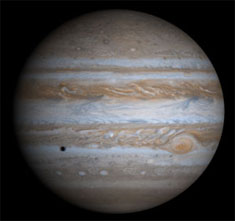
- It takes Jupiter 11.86 (Earth) years to orbit the sun.
- Jupiter has at least 67 moons.
- Ganymede, Jupiter’s larger moon, has a diameter larger than Mercury.
- Jupiter rotates very quickly, taking slightly less than 10 hours to complete one rotation of its axis. This is the quickest of all the planets in the Solar System.
- As a result of its quick rotation, Jupiter has an oblate shape, meaning that it bulges around the equator as if it has been squashed.
- Jupiter has very faint rings around it, mostly comprised of dust. Scientists believe that the main ring was formed out of material from two of Jupiter’s moons.
- The magnetic field of Jupiter is 14 times the strength of Earth’s, which is the largest of any planet in the Solar System.
- Jupiter is the only planet that has a center of mass with the sun that lies outside the sun itself.
- The axis of Jupiter is only tilted by 3.13 degrees, meaning Jupiter does not experience seasons like Earth.
- The adjective form of the word Jupiter is “Jovian” (for example, the largest Jovian moon is Ganymede). It used to be “jovial” but that now means happy, which was the mood associated with Jupiter in the past.
- Jupiter’s Great Red Spot is an enormous storm that has been raging for over 300 years. This storm is so wide that two Earth’s would fit inside of it.
- If Jupiter had been 80 times more massive nuclear fusion would have occurred in its core. Thus Jupiter would have become a star rather than a planet.
Uranus Facts
For thousands of years, mankind believed that there were only five planets in the solar system. But an astronomer called William Herschel discovered a new planet in 1781. Uranus orbits the Sun more than twice as far as Saturn. Uranus takes 84 Earth years to complete a single revolution around the Sun. Uranus is a gaseous planet like Saturn and Jupiter, with a distinct blue-green appearance, probably because of the concentration of methane in its upper atmosphere. Uranus has a core composed of silicate rock and metals, with a diameter of roughly 51,800 kilometers. Its core is covered by frozen methane ammonia and water ice 9600 kilometers deep. The most abundant elements in Uranus’ atmosphere are hydrogen and helium. Its atmosphere also contains methane acetylene and other hydrocarbons.
Uranus has an axial inclination of 98 degrees, which was discovered in 1829. Uranus also has a ring system that was discovered in 1977. People thought Uranus had only nine rings, but when Voyager two passed Uranus two more were identified. Uranus’ ring system probably did not form at the same time as the planet.
The widest ring prior to Voyager 2 visiting Uranus was the outermost ring, Epsilon, which measured from 22 to 96 kilometers. In 1986 Voyager 2 identified a new innermost ring called 1986UR2, which is 2500 kilometers wide. The narrowest complete rings are less than a kilometer wide.
- William Herschel discovered Uranus in 1781, making Uranus the first planet discovered in modern history.
- It takes Uranus roughly 84 (Earth) years to orbit the sun.
- The axis of Uranus is 98 degrees, so it almost lies sideways as it orbits the sun. In other words, the north and south poles on Uranus lie near where the equator is on Earth.
- Scientists don’t know why Uranus is tilted so much, while the other planets are not. One theory is that an Earth-sized planet crashed into it and forced its axis to shift.
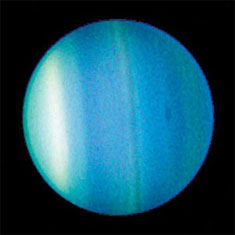
- As Uranus is tilted so much, its poles receive more energy from the sun than its equator. However, its equator is actually hotter. The reason for this is not currently known.
- The wind on Uranus can reach speeds of 900 kilometers per hour (560 miles per hour).
- Uranus has a mass of about 14 and a half times the mass of Earth. This makes it the lightest of the four gas giants.
- Uranus is the second least dense planet in the Solar System, after Saturn.
- Scientists believe that Uranus has a rocky core in the center, an icy mantle in the middle and an outer gas layer.
- Uranus was the second planet in the Solar System to be observed to have rings.
- The chemical element uranium, discovered in 1789, was named after the newly discovered planet Uranus.
- The gravity on Uranus is only 91% of the gravity on Earth.
- In 1977, Uranus was discovered to have a ring system. This ring system is extremely faint compared to the ring system of Saturn.
Mercury Facts
he Greeks and Romans called this small planet Hermes and Mercury respectively, for the messenger of their gods because, as observed from Earth, it moves faster than any other planet. This is because it is the closest planet to the Sun and has a year of just 88 Earth days, although a Mercurian day lasts 59 Earth days.
We didn’t know a great deal about Mercury until 1974 when the Mariner 10 probe analyzed Mercury. Mariner 10 is the only probe that has visited Mercury (It flew past Mercury 3 times during 1974-1975). Mercury is too near the Sun for it to be mapped by the Hubble Space Telescope, and Mariner 10 only managed to map 45% of the surface). The photographs it took portray Mercury as a barren, rocky landscape, it’s only distinguishing features being a large amount of craters marking Mercury’s surface.
Mercury has a diameter of 4878 kilometers and a mass of 3.30E23 kg. Its main distinguishing feature is the Caloris Basin, a lowland area that is 1350 kilometers across and is thought to have been caused by a very large and ancient meteorite.
Mercury is only 52 million kilometers away from the Sun (0.38 AU), and its temperature in the face of the Sun is 326 degrees C. At night, however, the surface chills to -150 degrees C. This no doubt plays an important role in eroding and changing the planets changing surface features.
Mercury has a highly eccentric orbit, at the perihelion (the point in its orbit where a planet is closest to the Sun) is only 46 million kilometers away from the Sun, and at the aphelion (the point in its orbit where a planet is furthest away from the Sun), it is 70 million kilometers).
For a long time, it was thought that Mercury’s day was the same length as its year so as to keep the same face to the Sun (just like the Moon does to the Earth), but was proven to be false in 1965. It is now known that Mercury rotates 3 times every 2 years.
Because of Mercury’s rotation and erratic orbit, a person on Mercury’s surface would observe some strange effects. At some longitudes, the Sun would seem to rise and then gradually increase in size. The Sun would then seem to stop, briefly, reverse course, stop again before resuming its path toward the horizon and decreasing in apparent size.
Mercury, like the Moon, has no plate tectonics, although Mercury is much denser (5.43 g/cm cubed).
Mercury’s core is made of iron, with a diameter of 3600 km to 3800 km. The silicate outer shell is only 500 to 600 km thick. At least some of the core is molten.
Radar observations of Mercury’s north pole (a region not mapped by Mariner 10) show evidence of water ice in the protected shadows of some craters. Mercury also has a small magnetic field (about 1% of Earth’s)
- Mercury has been known to humanity since ancient times (approximately 3,000 B.C.)
- Early civilizations believed Mercury was actually two different stars–one that appeared in the morning and one that appeared in the evening.
- Mercury is named after the messenger of the Roman gods.
- It wasn’t until Copernicus put forth his Sun-centered model of the Solar System in the 1500s that is was realized Mercury is a planet.
- Mercury has no moons or rings.
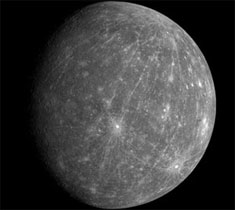
- It takes Mercury just under 88 (Earth) days to orbit the sun.
- Mercury orbits the sun in an ellipse, not a circle. In fact, it’s orbit is the least like a circle of all the planets and scientists say it has the most “eccentric orbit” in the Solar System.
- The temperature on Mercury ranges from -170C (-280F) during the night to 430C (800F) during the day. This is the most extreme temperature change of all the planets.
- Mercury’s axis has the smallest tilt of any of the planets in the Solar System, meaning that there are no seasons on its surface.
- Mercury rotates three times during two orbits of the sun. It is the only planet that doesn’t rotate exactly once every year.
- The orbit of Mercury was important in proving Albert Einstein’s theory of General Relativity.
- Mercury is the second densest planet in the Solar System. Only Earth has a higher density.
Venus Facts
Aphrodite to the Greeks and Venus to the Romans, the Goddess of Love. Today, Venus is still a sight of natural beauty and the brightest solar body visible from Earth except for the Sun and Moon. Venus is 108 million km from the Sun (0.72AU) and is the second of the terrestrial planets. It has a diameter of 12,104 kilometers and is almost exactly the same size as Earth, and has a solid surface and an atmosphere. Beyond that, however, the two planets are completely different. The Venusian atmosphere contains a thick cloud cover that covers 100% of the surface of Venus, all the time. This means that the surface of Venus is not detectable from Earth and that direct sunlight never penetrates the clouds. Though 17th and 18th-century astronomers were unaware of this, they tried to ‘map’ Venus. The 100% cloud cover was confirmed in the 20th century.
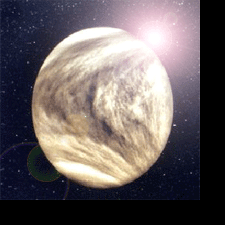 The atmosphere of Venus is composed mainly of carbon dioxide (96%). The clouds contain water vapor and sulfur dioxide, and squalls of acid rainfall on Venus. Massive electrical storms are also common, and their lightning, observed from Earth as ‘ashen light’, once was thought to light from Venusian cities.
The atmosphere of Venus is composed mainly of carbon dioxide (96%). The clouds contain water vapor and sulfur dioxide, and squalls of acid rainfall on Venus. Massive electrical storms are also common, and their lightning, observed from Earth as ‘ashen light’, once was thought to light from Venusian cities.
Since 1962, when the American Mariner 2 spacecraft flew near Venus, a dozen unmanned planetary probes have been launched from both the U.S.A and Russia (formerly the Soviet Union), and have begun to unlock the many secrets of Venus. In 1978, when the American Pioneer venus spacecraft used radar to ‘look’ beneath the clouds, the nature of Venus’ surface features were revealed. The picture painted by the returned data was that of barren rock, at a temperature of 482 degrees C. People had thought that there might be lush forests beneath Venus’ clouds, benefiting from the abundance of carbon dioxide. But the temperature was far too hot for water to exist in liquid form. The US spacecraft Magellan is the most recent probe and has produced detailed maps of Venus’ surface using radar.
Venus’ atmospheric pressure is 100 times greater than that of Earth’s. This means that it has been very difficult to conduct successful spacecraft landings. Four Soviet Venera spacecraft have landed on the surface, but could only get two pictures apiece before being crushed. Because of the Pioneer Venus project of 1978 and the Magellan project in 1989, we do have a vague idea of what Venus looks like. In the northern hemisphere, there is a vast upland region, which has been dubbed Ishtar Terra. The highest point is the Maxwell Mountains, that rise to 35,00 ft. There is also a great upland area in the southern hemisphere called Aphrodite Terra, which measures 11,200km, across. It also contains Venus’ deepest canyon, the Diana Chasme, whose floor is 9500 ft below the mean radius of the planet.
A Venusian day consists of 243 Earth days, and its year is 225 Earth days, which means it takes longer to rotate 360 degrees than it does for it to orbit the Sun once. Venus’ orbit is retrograde. In addition, the periods of Venus’ rotation and of its orbit are synchronized such that it always presents the same face toward Earth when the two planets are at their closest approach.
Venus probably had large amounts of water like Earth but has been boiled away. The surface of Venus is covered with lava flows. There are several large shield volcanoes and recently announced findings indicate Venus is still volcanically active.
Venus has an iron core of about 600km in diameter, a molten rocky mantle compromising the majority of the planet and a crust that is a lot stronger and thicker than anyone predicted. Venus doesn’t have a magnetic field.
- Venus is the brightest object in the sky after the Sun and the Earth’s moon.
- Ancient humans believed Venus to be two distinct stars, a morning star and an evening star.
- Venus is named after the Roman goddess of love.
- Earth and Venus are often called twin planets because of their similar size and position in the Solar System.
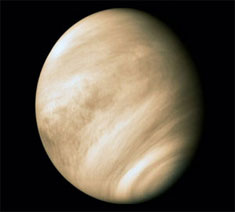
- Venus has no moons nor rings.
- It takes Venus just under 225 (Earth) days to orbit the sun.
- Venus has a very, very slow rotation about its axis. One “day” on Venus the time Venus to complete one rotation takes 243 (Earth) days. This means that a year on Venus lasts only about 2 days!
- It rotates counter-clockwise, unlike the other planets in the Solar System.
- The temperature on the surface of Venus is 462C (863F), making it the hottest of all the planets in the Solar System.
- The temperature on Venus doesn’t vary much between the night and day because of the slow movement of the winds across its surface.
- The surface of Venus is estimated to be between 300 and 400 million years old. Earth’s surface is about 100 million years old.
- Venus has a very weak magnetic field. This surprised scientists, who expected Venus to have a magnetic field similar in strength to Earth’s.
- Venus is the only planet in the Solar System to be named after a female figure.
- Very little is known about the interior of Venus, but it is thought to have a similar structure to Earth with a core, mantle, and crust due to its similar size.
- Venus orbits the sun in an ellipse, but its orbit is the closest to being a circle out of all the planets in the Solar System.
- When Venus is in line with Earth and the sun, it is the closest planet to us, at an average distance of 41 million kilometers (25.5 million miles) away.
Mars Facts
The early man thought that Mars was a distant, bloody battlefield. The Greeks and Romans named it Aries and Mars for their respective Gods of war. Iron oxide (rust) in Mars’ soil gives is a ruddy complexion.
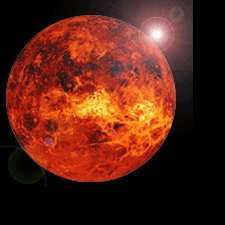 At the end of the nineteenth century, Giovanni Schiaparelli in Italy and Percival Lowell in the United States mapped what they thought to be ‘canals’ constructed by Martians to bring water from the ice caps to irrigate fields. In the twentieth century, many people still thought that a civilization might exist on Mars.
At the end of the nineteenth century, Giovanni Schiaparelli in Italy and Percival Lowell in the United States mapped what they thought to be ‘canals’ constructed by Martians to bring water from the ice caps to irrigate fields. In the twentieth century, many people still thought that a civilization might exist on Mars.
Mars is similar to Earth in many ways. Although it has a much smaller diameter compared to Earth (6739 kilometers), Mars has polar ice caps very similar to Earth’s. The Martian year is 687 Earth days, but a Martian day is 24.6 hours, is amazingly close to Earth’s. Mars has an atmosphere consisting of more than 95% carbon dioxide, but oxygen and water vapor are known to be present, and the Martian equatorial zone can reach temperatures of 20 degrees C, although the average temperature on Mars is -63 degrees C. At the Viking 2 landing site, a thin layer of water frost covered the ground each winter.
In 1965 the Mariner 4 spacecraft transmitted 22 close-up pictures of the planet. The images taken depicted a barren and rocky world, not capable of sustaining life. There was, however, evidence that water did once flow there. The Martian south polar ice cap was found to be half-frozen carbon dioxide (dry ice), but the north polar icecap was found to be almost entirely water.
One of Mars’ distinguishing features is Mount Olympus. Mount Olympus is a dormant volcano 25 kilometers higher than Mount Everest. The ‘canals’ that Percival Lowell thought were manmade, actually turned out to be a giant fracture zone that was 4800 kilometers across the Martian equator. Now called Mariner valley, the fracture zone is 200 kilometers wide and four times deeper than the Grand Canyon.
In 1976 two American Viking spacecraft became the first craft to survive to land on Mars. The Viking landers answered many questions about Mars, especially whether there was life on Mars. The answer was ‘probably not’. The landers conducted a lot of experiments to ascertain whether there was life on Mars, called the ‘Gas Exchange Experiment’.
Mars has a mass of 6.421E23 and has a mean density of 3.94g/cm cubed. It orbits the Sun at a distance of 227,940,000 kilometers (1.5237AU)
- Mars is the 4th planet from the Sun and last of the terrestrial planets.
- Mars is named after the Roman god of war.
- A common nickname for Mars is “The Red Planet.”
- Many people once believed Mars to possess intelligent life. This belief resulted from the discovery of lines that appeared to be too straight to occur naturally. It was later discovered, however, that the lines weren’t as straight as previously believed, and thus it was realized that there was no proof for intelligent life on Mars.
- Of all the planets other than Earth, Mars is the most hospitable to life.
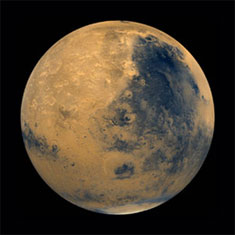
- Martians, or extraterrestrials from Mars, are a common character in science fiction books and movies.
- It takes Mars 687 (Earth) days to orbit the sun.
- Mars is the only planet, other than the Earth, that has polar ice caps. They are called Planum Boreum (northern cap) and Planum Australe (southern cap).
- Mars is tilted on its axis by about 25.19 degrees, which is similar to the axial tilt of the Earth (22.5 degrees). This means that Mars has seasons like the Earth, although they last nearly twice as long.
- Mars has the second most eccentric orbit out of all the planets in the Solar System, which means that its orbit is the second least like a circle.
- In the book ‘Gulliver’s Travels’, the author Jonathon Swift wrote about two moons of Mars, about 150 years before they were discovered.
- Mars has no magnetic field, although some scientists believe that Mars did have a magnetic field about 4 billion years ago.
- Water ice has been found under the surface of Mars, mostly below the polar caps.
Saturn Facts
Saturn is the last planet that is visible with the naked eye from Earth. Saturn is located 1.4 billion kilometers from Earth and has a diameter of 120,000 kilometers, making it the second-largest planet in our Solar system. Saturn takes 29.46 Earth years to complete a single revolution around the Sun, however, it’s day is only 10.25 hours, less than half of Earth’s.
Saturn, like Jupiter, has no solid surface, but rather a small rocky core the size of Earth, which is covered by a layer of frozen water and ammonia kept frozen through immense pressure, despite the temperature being 11,000 degrees C. Above this shell lies a sea of liquid metallic hydrogen 13,500 kilometers in-depth, which in turn is shrouded by a 30,000 kilometer thick layer of liquid hydrogen, with a temperature of -150 degrees C.
Saturn’s atmosphere consists of Ammonia clouds that swirl through the explosive combination of phosphine, ethane, methane, acetylene, methacrylate, and propane.
The most noticeable feature in Saturn’s atmosphere is Anne’s spot. It is a pale red feature in the southern hemisphere which is thought to be composed of phosphine, whilst not as large as the GRS, it is still a noticeable feature.
Saturn’s most prominent feature is its ring system. The diameter of these rings is the same distance between the Earth and the Moon. In 1610 Galileo Galilei first observed the rings, but could not find out what they were. He at first thought they were two large moons, but these ‘moons’ did not rotate or change position. In 1655 Christiaan Huygens discovered Saturn’s rings for what they were. When Voyager visited Saturn, we realized that there was not one, two, three or even four ring systems (as was previously thought). There were literally thousands of rings. The rings are divided into seven main rings. Closest to Saturn is the extremely faint D ring. The D ring merges into the more visible C ring. The C ring is approximately 17,400 kilometers wide. 31,400 kilometers above Saturn’s cloud tops, the C ring merges into the B ring. The B ring is the brightest of the main rings and is also the widest, except for the E ring. The Cassini division separates the B ring from the 14,400 km wide A ring. The F ring is located 3700 km beyond the outer edge of the A ring, and the G ring is located 33,120 km from the A ring. The E ring is very faint and is 89,300 km wide and is 145,000 km from Saturn’s cloud tops.
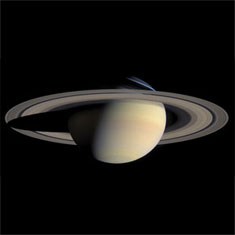
- An unusual quality of Saturn is that it gives off more energy than it receives from the Sun. This heat is believed to be generated from the planet’s gravitational compression as well as the friction created by the large amounts of helium found in the atmosphere.
- It takes Saturn 29.5 (Earth) years to orbit the sun.
- The winds on Saturn are by far the fastest of any planet in the Solar System. They have been measured at 1,800 kilometers per hour (1,100 miles per hour).
- Saturn is the least dense planet in the Solar System. It has a density less than water, so it would float!
- It takes Saturn an average of 10 and a half hours to complete one rotation about its own axis.
- Saturn appears a pale yellow color because its upper atmosphere contains ammonia crystals.
- The magnetic field on Saturn is slighter weaker than Earth’s magnetic field.
- Even though Saturn is called a gas giant, scientists believe it has a solid core.
- Saturn and Jupiter together contain 92% of all the mass from the planets in the Solar System.
- The interior of Saturn is very hot, reaching temperatures of up to 11,700C (21,000F).
- The outer atmosphere of Saturn contains 96% hydrogen and 3% helium. The rest is made up of small amounts of other elements, although scientists do not know their exact quantities.
- The average distance from the sun to Saturn is more than 1.4 billion kilometers (0.9 billion miles).
Neptune Facts
Neptune was discovered 65 years after Uranus by two men called Johann Galle and Heinrich Ludwig D’Arrest, although Galileo had seen it in 1613, he did not realize what it was.
Neptune is located 4.5 billion kilometers from the Sun, that’s more than three times as distant as Saturn. It takes 165 Earth years to orbit the Sun. Neptune’s diameter is roughly 49,242 kilometers. Its day is only 16.3 Earth hours. Neptune is very much like Uranus in physical composition, primarily hydrogen, helium, methane, and ammonia atmosphere.
When Voyager visited Neptune in 1989, our knowledge about the planet greatly increased. Six moons and four rings were discovered and the existence of a magnetic field was confirmed. Neptune’s mean temperature is -178 degrees C.
The most visually noticeable aspect of Neptune is the ‘Great Dark Spot’ (GDS). Located at a mean latitude of 22 degrees south and with an overall length of 30 degrees longitude, it is very much like the GRS. The Great Dark Spot is an elliptical, stormlike feature that rotated in an anticlockwise direction and is located above the surrounding cloud tops. The GDS completes a revolution of the planet in 18.3 hours, moving east to west.
Neptunes rings are very irregular, and at first, were thought to be incomplete arcs. It is now known that there are four thin rings around the planet.
- On 11 July 2011, Neptune made one complete orbit of the sun from the day it was discovered, i.e. it was the first complete Neptune year since it was discovered.
- Jean-Joseph Leverrier discovered Neptune, and as a result, Neptune was initially called Leverrier.
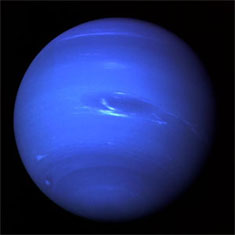
- The gravity on Neptune is the second largest of any planet in the Solar System, behind only Jupiter.
- Neptune orbits the sun at approximately 30 times the distance from the Earth to the sun.
- The discovery of Neptune’s largest moon Triton occurred just 17 days after the discovery of Neptune itself.
- Neptune possesses a storm similar to the Great Red Spot found on Jupiter. This storm is commonly referred to as the Great Dark Spot. Its size is roughly that of Earth.
- The is a second storm on Neptune known as the Small Dark Spot. It is the size of Earth’s moon.
- During the Voyager 2 mission to Neptune, it took 246 minutes (4 hours and 6 minutes) for signals from the spacecraft to reach Earth.
- The average temperature on Neptune is -214C (-353F).

